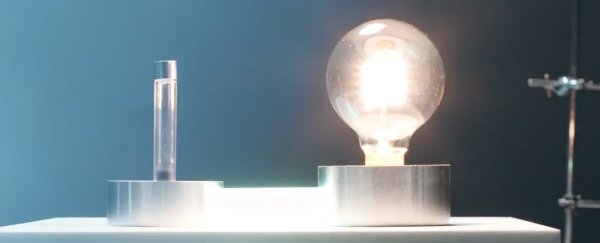For the first time, researchers have successfully generated electricity from americium, one of the radioactive elements we've pinned our hopes on as a promising alternative to rocket fuel, for powering farther and farther ventures out into space.
It's a new milestone in experiments with the synthetic element, which doesn't occur naturally but is a by-product of plutonium decay. Americium can be found in spent nuclear fuel, but over time it also accumulates in stored plutonium as the latter element undergoes beta decay.
Taking a small amount of americium, scientists were able to illuminate a single lightbulb in a specially shielded laboratory using heat produced by the element; but this tiny light could be a major first step.
Their futuristic vision is that pellets made from the element could be used to send probes deeper into space, or to power planetary rovers that can't rely on traditional types of power such as solar.
We already know that the longer spacecraft can stay powered up for, the more useful data they can send back, which makes the potential use of americium an exciting prospect.
"It is great to think that americium can be used in this way, recycling something that is a waste from one industry into a significant asset in another," says one of the researchers, Tim Tinsley from the National Nuclear Laboratory (NNL) in the UK.
"Seeing this lightbulb lit is the culmination of a huge amount of specialist technical work."
Several years of technical work in fact, involving the NNL, the University of Leicester in the UK, commercial company European Thermodynamics, and the European Space Agency (ESA).
While these organisations have been happy to announce the result, for now we'll have to be patient as we wait for a paper outlining the details of the work. We do know that the plutonium involved was sourced from the UK's stockpile – originally stored as a potential alternative to uranium for nuclear power.
"The americium in plutonium is potentially a problem for re-using the plutonium as new fuel," Adrian Bull from the NNL told World Nuclear News. "In extracting the americium from aged plutonium stocks, we end up with both the separated americium and also 'cleaner' plutonium – for potential re-use in the fuel cycle. So it's a win-win."
Getting to the stage of using americium in spacecraft is going to take more years of study and investment; some existing probes already use plutonium isotopes – and now scientists know it's possible to use americium in this way, too.
If we're really going to start exploring the Universe in a serious way, we're going to need some revolutionary types of fuel – and some really big spaceships. With each passing year though, scientists are making progress.
"Radioisotope power sources are an important technology for future European space exploration missions as their use would result in more capable spacecraft, and probes that can access distant, cold, dark and inhospitable environments," says one of the researchers, Richard Ambrosi from the University of Leicester.
"This is an important step in achieving these goals."
If space battery technologies like those involved in this americium experiment can be fully developed and used effectively, we might not have to say goodbye to our deep space probes quite as early in the future.
